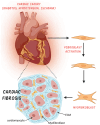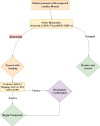Causes, Diagnosis, Treatment, and Prognosis of Cardiac Fibrosis: A Systematic Review
- PMID: 40291288
- PMCID: PMC12032538
- DOI: 10.7759/cureus.81264
Causes, Diagnosis, Treatment, and Prognosis of Cardiac Fibrosis: A Systematic Review
Abstract
Cardiac fibrosis, characterized by excessive extracellular matrix deposition, contributes to heart failure, arrhythmias, and myocardial dysfunction. Despite advances in understanding its mechanisms, targeted antifibrotic therapies remain limited. This review examines the causes, molecular mechanisms, diagnostic approaches, and therapeutic strategies for cardiac fibrosis. A systematic review of peer-reviewed studies was conducted, focusing on the etiology, diagnosis, treatment, and prognosis of cardiac fibrosis with no specific timeframe. The condition is driven by fibroblast activation, inflammatory pathways, and mechanical stress, with key contributing factors including ischemic heart disease, hypertension, diabetes, and aging. Diagnostic tools such as cardiac magnetic resonance imaging with T1 mapping and biomarkers play a crucial role, with natriuretic peptides offering both diagnostic and prognostic value. Galectin-3 has also shown promise as a prognostic marker. Current therapies, including RAAS inhibitors and beta-blockers, help prevent fibrosis progression but do not reverse established fibrosis. Emerging strategies such as plant-based compounds, gene therapy, fibroblast-targeting vaccines, and stem cell reprogramming show potential in preclinical studies. However, cardiac fibrosis remains a major driver of heart disease progression, and existing treatments remain limited. Major gaps include the lack of validated antifibrotic agents and challenges in translating preclinical findings into clinical applications. Further research is essential to develop effective targeted interventions.
Keywords: antifibrotic therapies; cardiac biomarker; cardiac fibrosis; fibroblast activation; heart failure.
Copyright © 2025, BaniHani et al.
Conflict of interest statement
Conflicts of interest: In compliance with the ICMJE uniform disclosure form, all authors declare the following: Payment/services info: All authors have declared that no financial support was received from any organization for the submitted work. Financial relationships: All authors have declared that they have no financial relationships at present or within the previous three years with any organizations that might have an interest in the submitted work. Other relationships: All authors have declared that there are no other relationships or activities that could appear to have influenced the submitted work.
Figures



References
-
- Cardiac fibrosis: cell biological mechanisms, molecular pathways and therapeutic opportunities. Frangogiannis NG. Mol Aspects Med. 2019;65:70–99. - PubMed
Publication types
LinkOut - more resources
Full Text Sources
